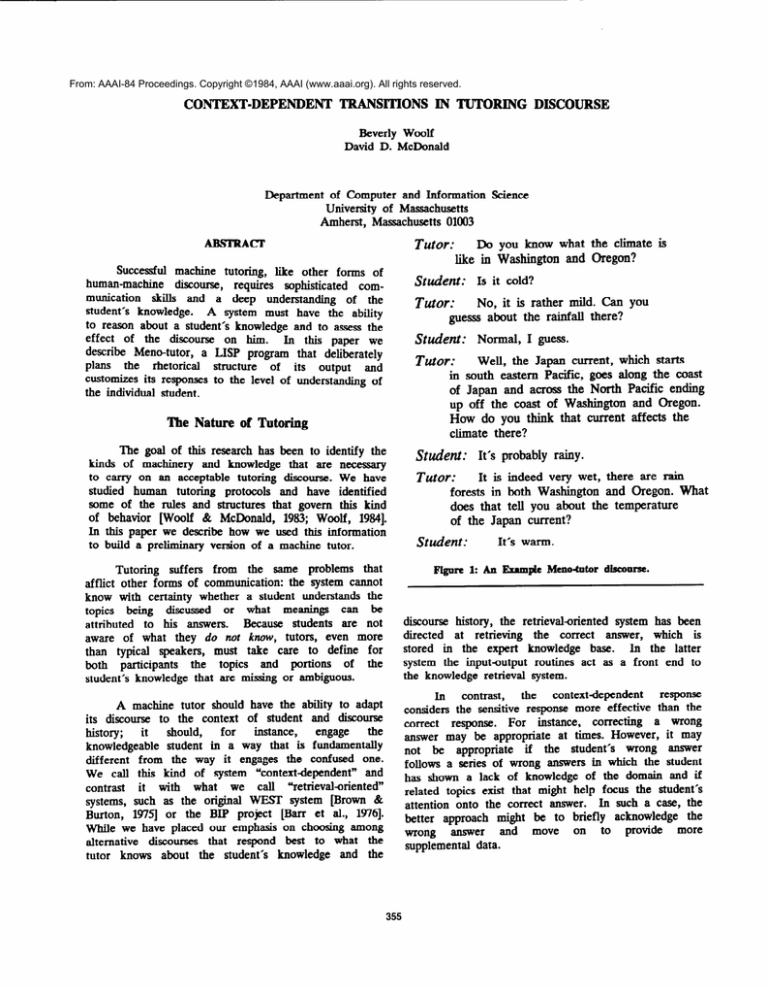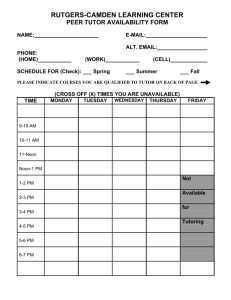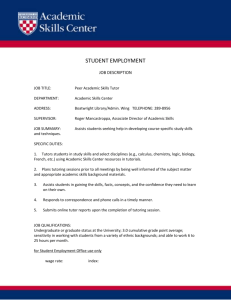
From: AAAI-84 Proceedings. Copyright ©1984, AAAI (www.aaai.org). All rights reserved.
CONTEXT-DEPENDENT
TRANSH’IONS
IN TUTORING
DISCOURSE
Beverly Woolf
David D. McDonald
Department
of Computer and Information
University of Massachusetts
Amherst, Massachusetts 01003
Tutor:
ABSTRACX
Successful machine tutoring, like other forms of
~~mamnachine
discourse, requires
sophisticated
communication
skills and a deep understanding
of the
student’s knowledge.
A system must have the ability
to reason about a student’s knowledge and to assess the
effect of the discourse on him.
In this paper we
describe Meno-tutor,
a LISP program that deliberately
Plans the rhetorical
structure
of its output
and
cw&mks
its responses to the level of understanding of
the individual student.
Science
Do you know what the climate
like in Washington and Oregon?
Student:
Is it cold?
Tutor:
No, it is rather mild. Can
guesss about the rainfall there?
Studertt:
is
you
Normal, I guess.
Tutor:
Well, the Japan current, which starts
in south eastern Pacific, goes along the coast
of Japan and across the North Pacific ending
up off the coast of Washington
and Oregon.
How do you think that current affects the
climate there?
The Nature of Tutoring
The goal of this research has been to identify the
kinds of machinery and knowledge that are necessary
to carry on an acceptable tutoring discourse. We have
studied human tutoring protocols and have identified
some of the rules and structures that govern this kind
of behavior [Woolf & McDonald, 1983; Woolf, 19841.
In this paper we describe how we used this information
to build a preliminary version of a machine tutor.
&deW
It’s probably
rainy.
Tutor:
It is indeed very wet, there are rain
forests in both Washington
and Oregon. What
does that tell you about the temperature
of the Japan current?
Student:
It’s warm.
Figure 1: An Example Meno-totor disamse.
Tutoring
suffers from the same problems that
afflict other forms of communication:
the system cannot
know with certainty whether a student understands the
topics being
discussed
or what meanings
can be
Because students are not
attributed
to his answers.
aware of what they do not know, tutors, even more
than typical speakers, must take care to define for
the topics
and portions
of the
both
participants
student’s knowledge that are missing or ambiguous.
discourse history, the retrievaloriented
system has been
directed
at retrieving
the correct answer, which is
In the latter
stored in the expert knowledge base.
system the inputoutput
routines act as a front end to
the knowledge retrieval system.
A machine tutor should have the ability to adapt
its discourse to the context of student and discourse
engage
the
instance,
for
should,
history;
it
knowledgeable
student in a way that is fundamentally
different
from the way it engages the confused one.
We call this kind of system “contextdependent”
and
contrast
it with what we call “retrieval-oriented”
systems, such as the original WEST’ system [Brown Bi
Burton, 1974 or the BIP project [Barr et al., 19761.
While we have placed our emphasis on choosing among
alternative
discourses that respond best to what the
tutor knows about the student’s knowledge and the
355
the
context-dependent
response
In
contrast,
considers the sensitive response more effective than the
correct
response.
For instance,
correcting
a wrong
answer may be appropriate at times. However, it may
if the student’s
wrong answer
not be appropriate
follows a series of wrong answers in which the student
has shown a lack of knowledge of the domain and if
related topics exist that might help focus the student’s
In such a case, the
attention onto the correct answer.
better approach might be to briefly acknowledge
the
more
to
provide
move
on
answer
and
wrong
supplemental data.
Examples from Meno-tutor
Tutor:
Do you think it rains much in Oregon?
As an example
of a discourse
produced
by
Meno-tutor
we present Figure 1.
Thisdiscourseis
modeled directly on a human tutoring dialogue recorded
by Stevens et al. [1982, pg 181.’ That is, we analyzed
the common transitions and speech patterns used in this
and twelve other human dialogues and defied
the
structures and knowledge necessary for a machine tutor
to behave the same way. In the example, the student’s
first two answers were wron$ and the system marked
the student as having limited knowledge
about the
topic. The question-answer
approach was then changed
because it was not working and the system chose,
instead, to tell the student about the “Japan Current,”
which is a dominant
influence
behind
the region’s
climate.
Student:
No.
Why do you think it doesn’t rain much
in Oregon?
Tutor:
Because the neighboring
Student:
Moving beyond
this “reverse engineering,”
we
have begun
to explore
the “tutoring
space”
our
apparatus
defines by varying
the domain
and the
particulars of the rules. The discourse in Figure 2, for
example, is based on the same domain as the first, but
is done in an alternative tutoring style, brought about
by modifying the “meta-rules” that govern whether the
tutor explores
the student’s
frontier
of knowledge
(Figure 1) or probes the student’s misconceptions about
the current topic as soon as the first mistake is made
(Figure 2).
states are dry.
Tutor:
The neighboring states are dry, but,
you can not generalize! from that. In fact,
it does rain a lot in Oregon. Can you guess
what causes the rain there?
Student:
Well, there are high mountains in the
region and the states border the Pacific Ocean.
Tutor:
Yes. The Pacific borders Oregon. How
do you think it is involved in the heavy rainfall
there?
Student:
Ocean air rises and cools upon reaching
the land
That is right.
Tutor:
Figure 2: A Second MenoCcltor Disconrsc.
wrong answer
misconception.
Two meta-rules
were modified
to achieve this
The first makes the tutor change
second discourse.
discourse
tactic
after
a set of topics
has been
completely discussed and the tutor has some confidence
In the
in its assessment of what the student knows.
first discourse, it was set at a more conservative value.
In the second discourse, it caused the shift in strategy
after a single wrong answer.
The second modified
meta-rule shifts the discourse to focus on the student’s
Typically,
this rule is triggered only
misconception.
after all topics have been covered and a misconception
In the second discourse this rule
has been observed.
modified
to eliminate
the first precondition,
WaS
resulting
in the rule being triggered
after a single
occurs
which
is linked
to
a common
Our second exploration of the tutoring space was
to substitute a new knowledge base for the facts about
rainfall, namely elementary
PASCAL looping concepts.
The
focus
of
this
PASCAL
tutor
is on
the
misconceptions
behind a student’s explicit programming
errors.
The model for the misconceptions drew on the
results of of extensive
cognitive
studies about how
novices learn PASCAL, constructs [Bonar, 1984; Soloway
et al., 19811.
The Meno-tutor
defines
a general
framework
within which tutoring rules can be defined and tested.
It is not an exhaustive tutor for any one subject but
rather a vehicle for experimenting
with tutoring in
several domains.
Though
the number
of discourses
produced
is still small (i.e., S), the fact that our
architecture
has been adapted to two quite different
domains and that we can produce varied but still quite
reasonable
discourses in short order by changing the
particulars of the rules, is evidence of its potential.
l The input text from the student is straight from Stevens et al.
We feed the concephA equivaIent of the student’s input to the
system by hand (i.e., what would have been the output of a
naturaI language comprehension system). The output is presentIy
produced by standard incremental replacement techniques but in
a way that should permit us to easiIy move over to a more
capable generator (we expect to use MUMBLE [1983D at the
point when we invest in a larger knowledge base and a richer
representation.
2 It’s not that those answers were simply %vrong,” but that they
refkct reasonable default assumptions about what happens in
“northern states.” An attempt to probe such assumptions is
made in the next dkourse, in Figurt 2.
356
The Architecture
of the Menoltutor
Meno-tutor
separates
the
planning
and
the
generation
of a tutorial
discourse into two distinct
components:
the tutoring component
and the surface
language generator.
The tutoring
component
makes
decisions about what discourse transitions to make and
what information
to convey or query, and the surface
language generator takes conceptual specifications from
the tutoring
component
and produces
the natural
language output. These two components interface at the
third level of the tutoring
component
as described
The knowledge
base for the tutor
is a
below.
pedagogical
with
annotated
network
KL-ONE
information about the relative importance of each topic
in the domain.
The tutoring component is best described as a set
of decision-units
organized into three planning
levels
that successively refine the actions of the tutor, (see
Figure 3). We refer to the network that structures these
decisions, defining the default and meta-level transitions
between them, as a Discourse Management Network or
The refinement
at each level maintains
the
DMN.
constraints
dictated by the previous level and further
system’s response.
elaborates the possibilities for the
PfZDhGOGIC
5TATC
4
At the highest level, the discourse is constrained to a
specific tutoring approach that determines, for instance,
how often the system will interrupt the student or how
often it will probe him about misconceptions.
At this
level a choice is made between approaches which would
diagnose the student’s knowledge (tutor), or introduce a
new topic (intruduce.)
At the second
level,
the
pedagogy is refined
into a strategy, specifying
the
approach
to be used. The choice here might be
between
exploring
the
student’s
competence
by
questioning
him, or describing the facts of the topic
without any interaction.
At the lowest level, a tactic is
selected to implement the strategy. For instance, if the
strategy involves questioning the student, the system can
choose from half a dozen alternatives,
e.g., it can
question
the student
about
a specific
topic,
the
dependency between topics, or the role of a subtopic.
Again, after the student has given his answers, the
system can choose from among eight ways to respond,
e.g., it can correct the student, elaborate on his answer,
or, alternatively, barely acknowledge his answer.
The tutoring component
presently contains forty
states, each organized as a LISP structure with slots for
functions
that are run when the state is evaluated.
The slots define such things as the specifications of the
text to be uttered, the next state to go to, or how to
I
CorlPLtTe
DC3Chlbt
CMPMATIC
DOMAIN
coha:cT
ACKHOWLtDbtMtf-1
PROPOSE
ANALOOY
Figure 3: The IHsconrse Management Network @MN).
357
update the student and discourse models.
The DMN is
structured like an augmented transition network (ATN);
it is traversed by an iterative routine that stays within
a predetermined
space of paths from node to node.
Paths, however, are not statically defined; the default
path can be preempted at any time by meta-rules that
move Meno-tutor
onto a new path, the action of the
meta-rule
corresponding
functionally
to the high-level
transitions
observed
in
human
tutoring.
These
preemptions
move
the
discourse
to paths
which
ostensibly are more in keeping with student history or
discourse history than the default path.
The ubiquity
of the meta-rules-the
fact that virtually any transition
between
tutoring
states (nodes) may potentially
be
preempted-represents
an important deviation from the
standard control mechanism of an ATN. Formally, the
behavior of Meno-tutor could be represented within the
definition
of an ATN; however the need to include
arcs for every meta-rule as part of the arc set of every
state would miss the point of our design.
The system presently contains 20 meta-rules; most
originate from more than one state and move the tutor
to a single, new state.
The preconditions
of the
meta-rules determine when it is time to move off the
default path: they examine data structures such as the
student model (e.g., Does the student know a given
topic?),
the
discourse
model
(e.g., Have
enough
questions been asked on a given topic to assess whether
the student knows it?), and the domain model (e.g., Do
related topics exist?).
Two meta-rules are described in
an informal notation in Figure 4 and in more detail in
the next section.
Sl-EXPLORE - a Strategic
From:
To:
Meta-rule
teach-data
explorcxwmpetency
Description:
Moves the tutor to begin a series
of shallow questions about a variety of topics.
Activation: The present topic is complete and
the tutor has little confidence in its
assessment of the student’s knowledge.
Bebavlor:
Generates an expository shift from
detailed examination of a single topic to a
shallow examination of a variety of topics
on the threshold of the student’s knowledge.
T6-AJMPLKITLY - a Tactical
From:
To:
Meta-rule
explicit-incorrect-acknowledgement
implicit-incorrect-acknowledgement
Description:
Moves the tutor to utter a brief
acknowledgement
of an incorrect answer.
Activation: The wrong answer threshold has
been reached and the student seems confused.
Behavior:
Shifts the discourse from a explicit
correction of the student’s answer to a
response that recognizes, but does not
dwell on, the incorrect answer.
FIgme 1: luformd
Notation of the Mebrdes.
An Example of Discourse Planning
do at this point is to move to a higher planning level
and to consider reformulating either the strategy or the
pedagogy of the utterance.
Therefore, the tutor returns
to the strategic level and to the parent state, teachdata,
as indicated by the up arrow in Snapshot 1.
In this section, we show how the decision-units
and meta-rules
interact in the tutoring process.
We
describe the generation of a portion of the discourse in
Figure
1. The example
discourse
begins after the
student’s second incorrect answer. Snapshots l-6 show
Meno-tutor’s
passage through a small portion of the
Discourse Management Network (DMN) as it plans and
generates the sample discourse.
As shown in Snapshot 1, the tutor begins in the
state
cxplicii-incorrect-acknawledgcmcnt,
which
is
a
tactical state the principal action of which is to say
something, in this case “No.”
Having said this, the
tutor still has “control”
of the discourse and can
continue
to elaborate
its response to the student’s
wrong answer.
In the present
design there is no
We
default path out of the state at the tactical level?
decided, in designing these rules, that the best thing to
Once in teach-data, we move along the default
path down to the tactical level to teach-spetificdato.
In general,
at this point, a meta-rule
might have
applied to take the tutor to a more particular tactical
state. At teach-specific-data an utterance is constructed
(current-topic),
from
the
specification
spezlfic-value
where current-topic has been carried forward from the
previous ply of the discourse and is “the climate in
Washington
and Oregon.” The attribute value of this
topic is “rather mild” (a canned phrase), and the
surface language generator renders it in this discourse
context as “It’s rather mild.”
From teach-specific-km&edge
there is again no
default path and the tutor moves up again to teuchdata
(Snapshot 2).
This time, however, the context has
changed and before teuchduta can move along the
3 With a different set of rules, the tutor might, for example,
CXX.ltiUUCspeaking or it might reinforce the student’s answer,
perhaps by repeating it <If elaborating part of it.
358
tutor to explore-competency, in effect establishing that
previous topics are complete and that a new topic can
The next most salient
topic in the
be explored.
knowledge base is “rainfall in Washington and Oregon”
and it becomes the current topic.
ITUTORI
Once in explore-competency, the tutor takes a
default path to the tactical level and to exploratoryquestion (Snapshot 3), where it asks another question on
a topic at the threshold of the student’s knowledge.
The utterance
this time is constructed
from
the
specification
question-model (current-topic) - “Can you
quess about the rainfall
there?”
At this point
Meno-tutor
continues
along a
default path and enters the tactical state evuluufe-input
(not shown) which receives and evaluates the student’s
answer. This answer is again wrong and the default
again
to
once
the
tutor,
moves
path
would
where
it
explicit-incorrect-acknowledgement,
However, this
normally correct the student, as before.
state is not evaluated because the context is different
and a new meta-rule,
T6-AIMPLICITLY
(Figure 4)
fires first, moving the tutor to another decision-unit
(Snapshot 4). The difference in context is two-fold: 1)
the student seems confused and 2) the test for wrong
Recognizing
a confused
answers threshold
is met.
student
is admittedly
a subjective
and
imprecise
inference for a machine tutor. In this implementation,
we have chosen to measure it as a function of the
number of questions asked, the number of incorrect
responses given, and the extent to which the student’s
In the
frontier
of knowledge
has been explored.
example discourse, two questions have been asked, two
answers have been incorrect, and the student’s frontier
of knowledge is barely explored. Therefore, the student
be
confused
and
the
meta-rule
is judged
to
T6-AIMPLICITLY
is triggered, forcing the system to
implicit-incorrectthe
tactical
state
move
to
UTTER
RLM-75
**
SPCClrlC
TCAC+d
.%
CULZR=NI
ROLE
i
ImID
aoLC
suapshot 1
default path as before, a meta-rule takes the tutor to a
The
context
has changed
different
decision-unit.
because the topics brought up until this point in the
discourse have been answered or resolved.
In detail,
what happened was that, when the tutor supplied the
correct answer to its own question (i.e., “It’s rather
mild”), the DMN register *question-complete*
was set,
satisfying one of the preconditions
of the meta-rule,
The
other
Sl-EXPLORE
(shown
in Figure
4).
precondition
for
this
meta-rule
was
already
satisfied,
namely that some topics related to the current topic
remain
to be discussed
(as indicated
by another
register).
When Sl-EXPLORE
is triggered it moves the
[TUTOR]
359
ITUTOR)
I
IMPUCIT
r4CceKC’
AcY*(Owl.LoeeMch
acknowledgement. Instead of correcting the student, this
state causes a response which implicitly recognizes, but
does not dwell on, the incorrect
answer. The tutor
responds with “Well, . . .”
There is no default path from implicit-incorrectacknowledgement and the tutor moves up to teuch-data
(Snapshot 5). Once here, a meta-rule, S3-DESCRIBE,
moves the tutor to describe-domain, terminating the
question-answer
approach
and beginning
a lengthy
descriptive passage about a single topic. This happened
because the threshold of wrong answers has been met
(as recorded by a register) and there is a link from the
major topic, “climate in Washington and Oregon,” to
an undiscussed
geographical
factor on which it is
dependent, namely the “Japan Current.”
ITUTOR
I
Snapsbot 6
From describedomain, the tutor takes the default
path to describe-specific-knwfedge
at the tactical level
(Snapshot
6) and constructs
an utterance
from the
specificdescribe
(current-topic).
specification
specificdescribe enunciates
each attribute of its argument and
Meno-tutor says “the Japan Current, which starts in the
Southeast Pacific, goes along the coast of Japan and
across the North Pacific, ending up off the coast of
Washington and Oregon.”
snapshot
5
360
Current
status
At
this point
in our
research,
the tutor’s
knowledge of two domains is shallow and, as mentioned
the tutoring
not yet interfaced
above,
we have
component with the surface language generator.
Our
intent is to develop a complex knowledge base, in
either the domain of rainfall or PASCAL, to extend
the surface language generator to deal with the domain,
and to build a simple natural
language
parser to
understand the student’s input.
REFERENCES
Barr, A., Beard,
M., & Atkinson,
R. C., ‘The
Computer as a Tutorial Laboratory: The Stanford
BIP Project,” in the Intemational Journal of
Man-Machine Studies, 8, 1976.
Bow,
J.,
Understanding
the
Bugs
of
Novice
Programmers, Ph.D. Dissertation, Department of
Computer and Information Science, University
Massachusetts, Amherst, Mass., 1984.
of
Brown, J. S. & Burton, R. R., “Multiple Representations
of Knowledge for Tutorial Reasoning,” in D.
Bobrow h A. Collins, (Eds),
Representation and
Understanding:
Studies
in
Cognitive
SCikTlCC,
Academic Press, New York., 1975.
McDonald, D., “Natural Language Generation as a
Computational Problem: an Introduction,” in M.
Brady & R. Benvick (eds.), Computational Models
of Discourse, MlT Press, Cambridge, Mass, 1983.
Soloway, E., Woolf, B., Rubin, E., Barth, P.,“MenoII:
An
Intelligent
Tutoring
System for Novice
Programmers”, Proceedings of the International
Joint
Conference
Vancouver,
in
Artificial
Intel1igence ,
British Columbia, 1981.
Stevens, A., Cdlins, A., & Goldin, S., ‘Diagnosing
Student’s Misconceptions in Causal Models,” in
International Journal of Man-Machines
Studies, 11,
1978 and in Sleeman & Brown (eds.), Intelligent
Tutoring Systems, Academic Press, Cambridge, MA,
1982.
Woolf,
B., Context-Dependent Planning in a Machine
Ph.D.
Dissertation,
Computer
and
Information Sciences, University of Massachusetts,
Amherst, MA, 1984.
Tutor,
D., “Human-Computer
Woolf,
B., & McDonald,
Discourse in the Design of a Pascal Tutor,” CHZ
83: Human Factors in Computer Systems, ACM,
361




